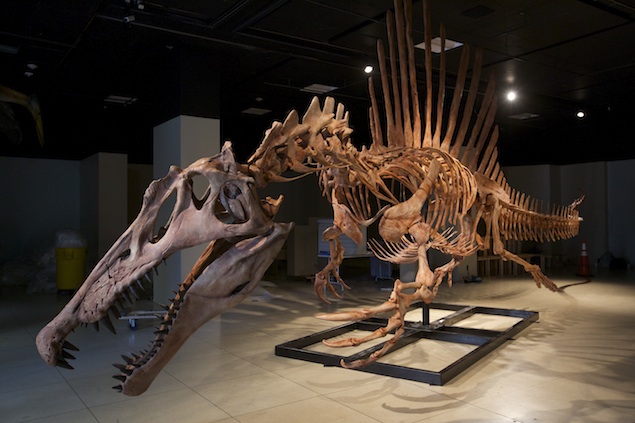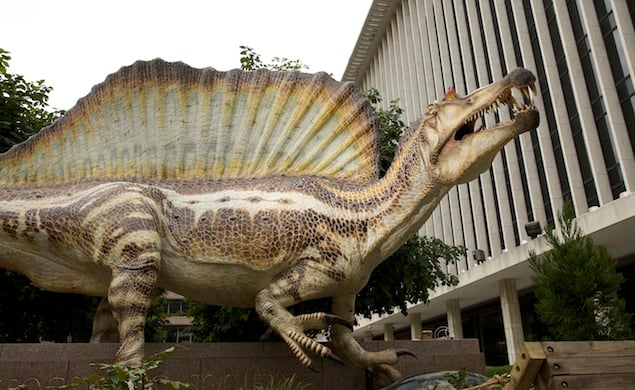When the dinosaur hall at the Smithsonian Natural History Museum closed this April to undergo a $48 million renovation, Washingtonians lost a valuable provider of their Jurassic fix. That exhibit won’t be finished until 2019, but fear not, dinosaur obsessives—today the National Geographic Museum opens its own exhibit featuring a prehistoric carnivore so ferocious that scientists now say it could tear the Smithsonian’s puny Tyrannosaurus rex to pieces.
“Spinosaurus: Lost Giant of the Cretaceous” showcases a 50-foot-long skeletal model of its eponymous dinosaur, crafted after the discovery of new fossils found in the Moroccan desert and painstaking analysis of past remains and records. It’s the biggest known predatory dinosaur ever, nine feet longer than the largest T. rex on record. Sure, the two species were separated by about 35 million years—but that doesn’t mean we can’t fantasize about a good ol’ fashioned dino brawl, as the makers of 2001’s Jurassic Park III did when they had them square off in that oft-ignored sequel. (For the record, Spinosaurus won.)
But just as impressive as Spinosaurus’s power is how paleontologists found it. That story is also told in National Geographic’s exhibit, beginning with German paleontologist Ernst Freiherr Stromer von Reichenbach’s naming of the new species in 1915 after its fossils were uncovered in Egypt.
Stromer displayed the find in a Munich museum. An outspoken critic of Hitler, he tried to have his specimen moved to a safer place during World War II, but the museum’s Nazi director refused. The bones were destroyed in an Allied bombing raid in 1944, and Stromer, who also lost two sons in the war, sank into obscurity.
After that, the tale wends from a Milanese museum to the black market fossil bazaars of Morocco as paleontologist Nizar Ibrahim hunted for the most important cache of Spinosaurus fossils since Stromer’s time. “A dinosaur detective story,” Ibrahim called it. The National Geographic Museum’s skeleton is a composite based on the Moroccan bones uncovered last year, smaller remains scattered in museums around the globe, and records of the original Egyptian dig for Spinosaurus more than 100 years ago.

Ibrahim’s discovery led to a number of revelations about the enigmatic creature that were published for the first time in the journal Science yesterday. The research team revealed that Spinosaurus is history’s only known semiaquatic dinosaur, adapted to spend a large amount of time in the water hunting.
They proved that Spinosaurus’s snout— long and narrow like a crocodile, not fat like a T. rex—had nostrils placed high up on the skull, so the dinosaur could breathe while its jaw was submerged underwater. And it had pressure sensors to detect the movement of nearby fish, just like a crocodile.
The team even solved “the riddle of the sail,” as University of Chicago paleontologist Paul Sereno put it. People have argued about the purpose of the “spine” part of Spinosaurus since its unearthing. Some said it was meant to trap or disperse heat, or was used for fat storage. But Ibrahim and Sereno now believe it was used as a display—as Spinosaurus swam looking for prey, the sail would stick out of the water as a warning to other predators to stay out of its hunting grounds.
It’s clear that National Geographic wants people to get excited about Spinosaurus—the story of the new findings is on the cover of its October issue, and a PBS special will air on November 5. You can also check out a life-size flesh replica of the dinosaur in the museum’s courtyard—and, yes, there are baskets upon baskets of Spinosaurus plush dolls in the gift shop.
“Spinosaurus: Lost Giant of the Cretaceous” runs until April 12. Admission to the National Geographic Museum is $11 for adults. Find dinosaur enthusiast Michael Gaynor on Twitter at @michael_gaynor.














